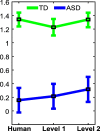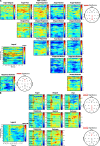Improved emotion differentiation under reduced acoustic variability of speech in autism
- PMID: 38486293
- PMCID: PMC10941423
- DOI: 10.1186/s12916-024-03341-y
Improved emotion differentiation under reduced acoustic variability of speech in autism
Abstract
Background: Socio-emotional impairments are among the diagnostic criteria for autism spectrum disorder (ASD), but the actual knowledge has substantiated both altered and intact emotional prosodies recognition. Here, a Bayesian framework of perception is considered suggesting that the oversampling of sensory evidence would impair perception within highly variable environments. However, reliable hierarchical structures for spectral and temporal cues would foster emotion discrimination by autistics.
Methods: Event-related spectral perturbations (ERSP) extracted from electroencephalographic (EEG) data indexed the perception of anger, disgust, fear, happiness, neutral, and sadness prosodies while listening to speech uttered by (a) human or (b) synthesized voices characterized by reduced volatility and variability of acoustic environments. The assessment of mechanisms for perception was extended to the visual domain by analyzing the behavioral accuracy within a non-social task in which dynamics of precision weighting between bottom-up evidence and top-down inferences were emphasized. Eighty children (mean 9.7 years old; standard deviation 1.8) volunteered including 40 autistics. The symptomatology was assessed at the time of the study via the Autism Diagnostic Observation Schedule, Second Edition, and parents' responses on the Autism Spectrum Rating Scales. A mixed within-between analysis of variance was conducted to assess the effects of group (autism versus typical development), voice, emotions, and interaction between factors. A Bayesian analysis was implemented to quantify the evidence in favor of the null hypothesis in case of non-significance. Post hoc comparisons were corrected for multiple testing.
Results: Autistic children presented impaired emotion differentiation while listening to speech uttered by human voices, which was improved when the acoustic volatility and variability of voices were reduced. Divergent neural patterns were observed from neurotypicals to autistics, emphasizing different mechanisms for perception. Accordingly, behavioral measurements on the visual task were consistent with the over-precision ascribed to the environmental variability (sensory processing) that weakened performance. Unlike autistic children, neurotypicals could differentiate emotions induced by all voices.
Conclusions: This study outlines behavioral and neurophysiological mechanisms that underpin responses to sensory variability. Neurobiological insights into the processing of emotional prosodies emphasized the potential of acoustically modified emotional prosodies to improve emotion differentiation by autistics.
Trial registration: BioMed Central ISRCTN Registry, ISRCTN18117434. Registered on September 20, 2020.
Keywords: Autism; Electroencephalography; Emotion; Naturalness; Pediatrics; Prosody; Sensory variability; Speech; Voice.
© 2024. The Author(s).
Conflict of interest statement
The authors declare that they have no competing interests.
Figures





Similar articles
-
Electroencephalographic Correlate of Mexican Spanish Emotional Speech Processing in Autism Spectrum Disorder: To a Social Story and Robot-Based Intervention.Front Hum Neurosci. 2021 Feb 26;15:626146. doi: 10.3389/fnhum.2021.626146. eCollection 2021. Front Hum Neurosci. 2021. PMID: 33716696 Free PMC article.
-
Neuronal and behavioral affective perceptions of human and naturalness-reduced emotional prosodies.Front Comput Neurosci. 2022 Nov 18;16:1022787. doi: 10.3389/fncom.2022.1022787. eCollection 2022. Front Comput Neurosci. 2022. PMID: 36465969 Free PMC article.
-
Functional alterations of lateral temporal cortex for processing voice prosody in adults with autism spectrum disorder.Cereb Cortex. 2024 Sep 3;34(9):bhae363. doi: 10.1093/cercor/bhae363. Cereb Cortex. 2024. PMID: 39270675
-
Multichannel Perception of Emotion in Speech, Voice, Facial Expression, and Gesture in Individuals With Autism: A Scoping Review.J Speech Lang Hear Res. 2022 Apr 4;65(4):1435-1449. doi: 10.1044/2022_JSLHR-21-00438. Epub 2022 Mar 22. J Speech Lang Hear Res. 2022. PMID: 35316079
-
Pain perception as hierarchical Bayesian inference: A test case for the theory of constructed emotion.Ann N Y Acad Sci. 2024 Jun;1536(1):42-59. doi: 10.1111/nyas.15141. Epub 2024 Jun 5. Ann N Y Acad Sci. 2024. PMID: 38837401 Review.
References
Publication types
MeSH terms
Associated data
Grants and funding
LinkOut - more resources
Full Text Sources
Medical

